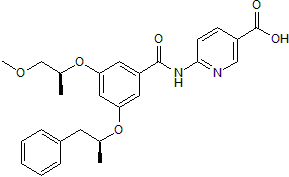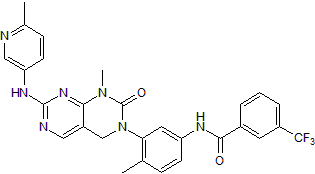Glucokinase/GCK Products
Hexokinases phosphorylate hexose to form hexose 6-phosphate, the first step for hexose metabolism. There are four mammalian hexokinases (I, II, III and IV) and hexokinase IV is commonly known as glucokinase (GCK). Unlike hexokinase I, II and III, which have high affinity for glucose and are strongly inhibited by the product, glucose-6-phosphate, GCK has much lower affinity for glucose and is not inhibited by the product. Consequently, GCK has a Km for glucose of approximately 7 mM, which is 100 times higher than that of hexokinase I, II, and III. This unique enzymatic property of GCK allows it to respond to blood glucose levels and contribute to the maintenance of blood glucose levels within the normal physiological range of 4 mM to 6 mM. In the pancreatic islets, GCK serves as a glucose sensor to control insulin release in the beta cells, and to control glucagon release in the alpha cells. In hepatocytes, GCK responds to changes of ambient glucose levels by increasing or reducing glycogen synthesis. Mutations in GCK have been associated with non-insulin-dependent diabetes mellitus, maturity-onset diabetes of the young type 2, and hyperinsulinemia of infancy. The enzyme activity was measured using a phosphatase coupled kinase assay.
62 results for "Glucokinase/GCK" in Products
62 results for "Glucokinase/GCK" in Products
Glucokinase/GCK Products
Hexokinases phosphorylate hexose to form hexose 6-phosphate, the first step for hexose metabolism. There are four mammalian hexokinases (I, II, III and IV) and hexokinase IV is commonly known as glucokinase (GCK). Unlike hexokinase I, II and III, which have high affinity for glucose and are strongly inhibited by the product, glucose-6-phosphate, GCK has much lower affinity for glucose and is not inhibited by the product. Consequently, GCK has a Km for glucose of approximately 7 mM, which is 100 times higher than that of hexokinase I, II, and III. This unique enzymatic property of GCK allows it to respond to blood glucose levels and contribute to the maintenance of blood glucose levels within the normal physiological range of 4 mM to 6 mM. In the pancreatic islets, GCK serves as a glucose sensor to control insulin release in the beta cells, and to control glucagon release in the alpha cells. In hepatocytes, GCK responds to changes of ambient glucose levels by increasing or reducing glycogen synthesis. Mutations in GCK have been associated with non-insulin-dependent diabetes mellitus, maturity-onset diabetes of the young type 2, and hyperinsulinemia of infancy. The enzyme activity was measured using a phosphatase coupled kinase assay.
| Reactivity: | Human, Mouse |
| Details: | Mouse IgG1 Monoclonal Clone #849520 |
| Applications: | WB |
| Source: | E. coli |
| Accession #: | P35557 |
| Applications: | EnzAct |
| Reactivity: | Human, Mouse, Rat |
| Details: | Mouse IgG1 Monoclonal Clone #OTI3E3 |
| Applications: | IHC, WB, ICC/IF |
| Applications: | ELISA |
| Reactivity: | Human |
| Details: | Rabbit IgG Polyclonal |
| Applications: | IHC, ICC/IF |
Recombinant Monoclonal Antibody
| Reactivity: | Human, Mouse, Rat |
| Details: | Rabbit IgG Monoclonal Clone #4K9D5 |
| Applications: | WB, IP |
| Reactivity: | Human |
| Details: | Mouse IgG1 Monoclonal Clone #4G6 |
| Applications: | WB, ELISA |
| Applications: | ELISA |
| Applications: | ELISA |
| Applications: | ELISA |
Recombinant Monoclonal Antibody
| Reactivity: | Human |
| Details: | Rabbit IgG Monoclonal Clone #223 |
| Applications: | ELISA |
| Reactivity: | Human |
| Details: | Mouse IgG1 kappa Monoclonal Clone #3C7 |
| Applications: | WB, ELISA |
| Reactivity: | Human |
| Details: | Mouse IgG1 kappa Monoclonal Clone #1G10 |
| Applications: | WB, ELISA |
| Applications: | WB |
Recombinant Monoclonal Antibody
| Reactivity: | Human |
| Details: | Rabbit IgG Monoclonal Clone #223 |
| Applications: | ELISA |
Recombinant Monoclonal Antibody
| Reactivity: | Human |
| Details: | Rabbit IgG Monoclonal Clone #223 |
| Applications: | ELISA |
| Reactivity: | Human, Mouse, Rat |
| Details: | Mouse IgG1 Monoclonal Clone #OTI3E3 |
| Applications: | IHC, WB, ICC/IF |
| Reactivity: | Human, Mouse, Rat |
| Details: | Mouse IgG1 Monoclonal Clone #OTI3E3 |
| Applications: | IHC, WB, ICC/IF |
| Reactivity: | Human, Mouse, Rat |
| Details: | Mouse IgG1 Monoclonal Clone #OTI3E3 |
| Applications: | IHC, WB, ICC/IF |
Glucokinase activator
| Chemical Name: | 6-[[3-[(1S)-2-Methoxy-1-methylethoxy]-5-[(1S)-1-methyl-2-phenylethoxy]benzoyl]amino-3-pyridinecarboxylic acid |
| Purity: | ≥98% (HPLC) |
Ras signaling inhibitor; inhibits Ack1 and GCK
| Chemical Name: | N-[3-[1,4-Dihydro-1-methyl-7-[(6-methyl-3-pyridinyl)amino]-2-oxopyrimido[4,5-d]pyrimidin-3(2H)-yl]-4-methylphenyl]-3-(trifluoromethyl)benzamide |
| Purity: | ≥98% (HPLC) |
Recombinant Monoclonal Antibody
| Reactivity: | Human |
| Details: | Rabbit IgG Monoclonal Clone #223 |
| Applications: | ELISA |
Recombinant Monoclonal Antibody
| Reactivity: | Human |
| Details: | Rabbit IgG Monoclonal Clone #223 |
| Applications: | ELISA |
Recombinant Monoclonal Antibody
| Reactivity: | Human |
| Details: | Rabbit IgG Monoclonal Clone #223 |
| Applications: | ELISA |
| Reactivity: | Human, Mouse, Rat |
| Details: | Mouse IgG1 Monoclonal Clone #OTI3E3 |
| Applications: | IHC, WB, ICC/IF |

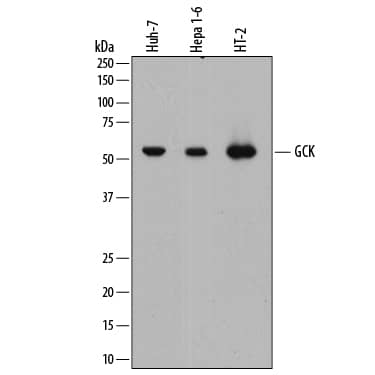


![Western Blot: Glucokinase/GCK Antibody (OTI3E3) [NBP1-47778] Western Blot: Glucokinase/GCK Antibody (OTI3E3) [NBP1-47778]](https://resources.bio-techne.com/images/products/Glucokinase-GCK-Antibody-3E3-Western-Blot-NBP1-47778-img0021.jpg)
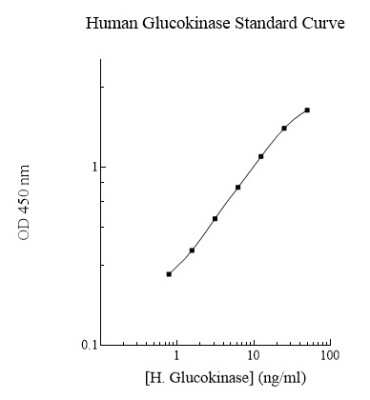
![Immunocytochemistry/ Immunofluorescence: Glucokinase/GCK Antibody [NBP1-81742] Immunocytochemistry/ Immunofluorescence: Glucokinase/GCK Antibody [NBP1-81742]](https://resources.bio-techne.com/images/products/Glucokinase-GCK-Antibody-Immunocytochemistry-Immunofluorescence-NBP1-81742-img0005.jpg)
![Western Blot: Glucokinase/GCK Antibody (4K9D5) [NBP3-16579] Western Blot: Glucokinase/GCK Antibody (4K9D5) [NBP3-16579]](https://resources.bio-techne.com/images/products/Glucokinase-GCK-Antibody-4K9D5-Western-Blot-NBP3-16579-img0001.jpg)
![Western Blot: Glucokinase/GCK Antibody (4G6)BSA Free [NBP2-37579] Western Blot: Glucokinase/GCK Antibody (4G6)BSA Free [NBP2-37579]](https://resources.bio-techne.com/images/products/Glucokinase-GCK-Antibody-4G6-Western-Blot-NBP2-37579-img0003.jpg)
![ELISA: Rat Glucokinase/GCK ELISA Kit (Colorimetric) [NBP2-67982] - Rat Glucokinase/GCK ELISA Kit (Colorimetric)](https://resources.bio-techne.com/images/products/nbp2-67982_rat-glucokinase-gck-elisa-kit-colorimetric-13220241620466.jpg)
![ELISA: Mouse Glucokinase/GCK ELISA Kit (Colorimetric) [NBP2-67981] - Mouse Glucokinase/GCK ELISA Kit (Colorimetric)](https://resources.bio-techne.com/images/products/nbp2-67981_mouse-glucokinase-gck-elisa-kit-colorimetric-13220241626115.jpg)
![ELISA: Human Glucokinase/GCK ELISA Kit (Chemiluminescence) [NBP2-67980] - Human Glucokinase/GCK ELISA Kit (Chemiluminescence)](https://resources.bio-techne.com/images/products/nbp2-67980_human-glucokinase-gck-elisa-kit-chemiluminescence-132202416211385.jpg)
![Western Blot: Glucokinase/GCK Antibody (223) [NBP2-89787] Western Blot: Glucokinase/GCK Antibody (223) [NBP2-89787]](https://resources.bio-techne.com/images/products/Glucokinase-GCK-Antibody-223-Western-Blot-NBP2-89787-img0001.jpg)
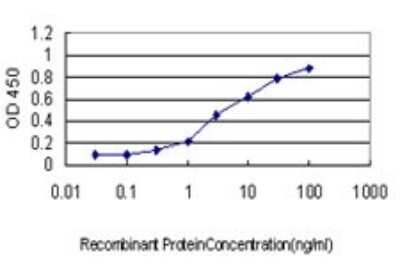
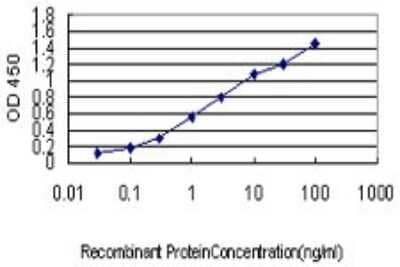
![Western Blot: Glucokinase/GCK Overexpression Lysate [NBP2-09947] Western Blot: Glucokinase/GCK Overexpression Lysate [NBP2-09947]](https://resources.bio-techne.com/images/products/GCK-Overexpression-Lysate-Adult-Normal-Western-Blot-NBP2-09947-img0001.jpg)


